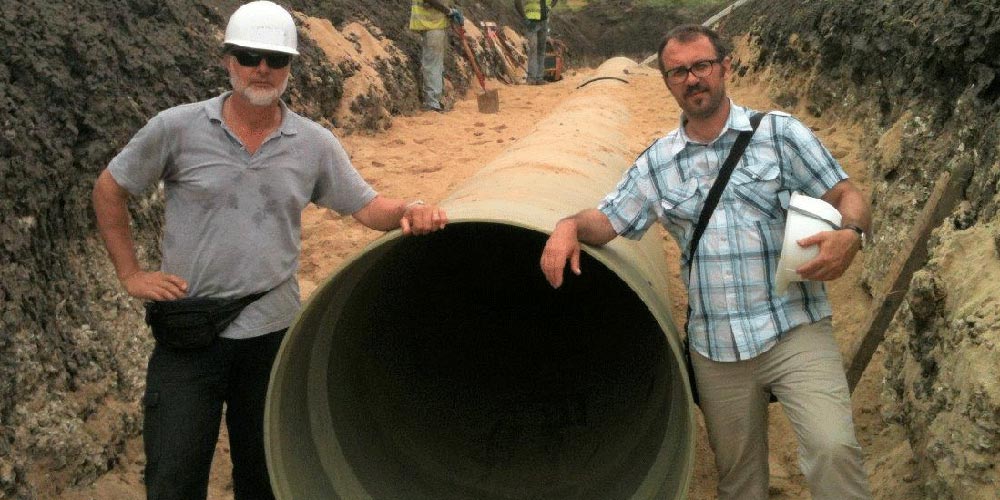How to get guaranteed success of your pipeline field test even if the project is implemented in the roughest terrain?
When you start a pipeline installation project, you will undoubtedly get numerous questions. The pipe installation company will keep asking you to make certain decisions, while the final result will depend on your answers.
Do you even know what these questions will be?
Do not worry if you are a little uncertain as to what I have in mind. I will explain.
Many companies initiate projects without being aware of what lies ahead of them. They know the pipes are well-made, where and who will install them. What they do not know is that they will experience difficult situations that need to be solved. If the right solution does not come up, the pipeline installation project may go wrong in terms of defects, leaks, delays, complaints, and similar.
Let me explain with an example of what you can expect if you work alone, without a specialized and independent GRP pipe supervisor. Based on my experience, I can tell you what the first question will be. It will be about the backfill material.
Backfill material has to adhere to certain requirements to be classified as suitable. However, it is difficult to come by the material that would meet all the requirements and thus be completely suitable.
Can we use the material resulting from the excavation, although it does not fully comply with the specifications?
Many times the contractors will ask you this question.
And then you may find yourself in a situation where the pipe manufacturer will suggest one thing, while the contractor will suggest just the opposite. And it is completely understandable that you should not have all the answers. You are managing the project and you should not be the target of such specific questions. But unfortunately, the final decision will be critical either to the economic final result or to the pipeline performance:
- The cost of installation will be significantly higher if you have the option to use backfill but choose not to.
- On the contrary, if you decide to use the backfill material and it turns out that it is not appropriate, the pipeline will not pass the field test and the consequences will be serious.
Throughout all the years of checking and correcting pipeline installation, I have come across another situation that causes many failures. I am talking about the angular deflection.
Stories related to this issue are always very similar. The pipe manufacturer specifies the allowed angular deflection for pipes of various diameters which sometimes do not meet the requirements.
Do you know what to say if the contractor asks you: “The theoretical angular deflection is not met. Should I disassemble the pipe and not meet the deadline or leave it as it is?”
I have mostly seen 2 scenarios:
- I saw the pipeline completely damaged while the contractor tried to correct the angular deflection, although it was not really needed. The task to correct the deflection is very difficult and may damage the pipe.
- In some other cases, I found out that the angular deflection was not corrected and the final result was a pipeline explosion.
But make no mistake. If you turn to the parties involved in the project for advice, you have to be aware that each of them will act in their best interest. Thus, supervisors of each party will provide you with a different answer and you will be even more confused.
Why does this happen?
This situation is very common. During the process of buying the pipes or choosing the civil contractor, each provider gives you a lot of suggestions and guarantees about their services. But they do not tell you that at certain points they will not be the ones making the key decisions.
However, there is a shortcut to guaranteed success even if the project is technically demanding, far away from your office, and implemented in the roughest terrain.
Read this article to the end. I will reveal to you how to proceed and be sure at all times that you are on the right track.
Right from the beginning, you need to include 3 milestones in your plan:
- audit of the pipeline project by an independent GRP-specialized company;
- examination of GRP pipes prior to delivery and by a company that is specialized in manufacturing technology;
- involvement of a GRP pipeline supervisor from the day the pipes arrive on site. The first audit is done during the unloading.
But take care with the supervision services!
The task that a GRP independent supervisor must accomplish is very demanding, and it is not enough to have a lot of experience and knowledge about GRP pipes and installation.
The key to success is how the independent supervisor implements each small step that leads the project to guaranteed success.
The correct way to proceed is to analyze the complete process. This is from the manufacturing tolerances to the handling, from the engineering project to the installation and tests. Only then make the first move.
What is the biggest mistake?
The biggest mistake is to get a supervisor that considers each stage separately.
When you get the right independent supervisor, you can finally relax. You will have the time to focus on the big picture and develop a clear strategy for the next move. Your profits will start soaring. You will know exactly what to do next and what your costs will be from day one.
In the end, you will know that the pipeline was installed properly, that there will not be any unexpected troubles and complaints, and that you will be able to move on to other projects.
Do you want to get guaranteed success of your pipeline field test even if the project is implemented in the roughest terrain?

